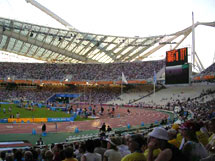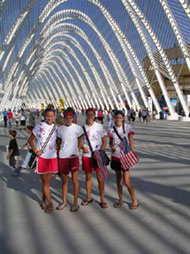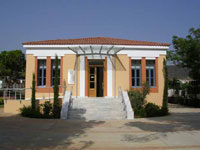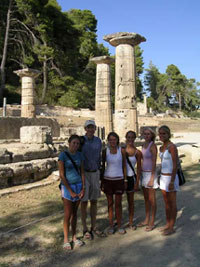
WEB JOURNAL FROM 2004 ATHENS OLYMPICS
 August 27, 2004
August 27, 2004
Athens
2:00 PM
Caption: View of the Calatrava roof of the Olympic Track and Field Stadium.
A few final notes from Athens before we leave for home tomorrow. With respect to the architecture of the Athens Olympic Games, a number of the buildings and structures here have been designed by the Spanish architect Santiago Calatrava. There are several prominent ones, the velodrome that I have only seen photographs of but which I like very much, and the new $132 million roof for the existing track and field stadium (see photo). The roof soars from the east and west sides of the stadium and meets only at the north and south ends, leaving the central area of the stadium open to the air. Many people that I have spoken with think that the design is successful and that the roof creates an attractive and pleasing environment, and I would agree. The roof appears to be light and almost floating over the sides of the stadium. The Olympic flame is contained within a single vertical element at the structure’s north end that is in keeping with the roof, but is a bit on the minimal side.
 Calatrava also designed the ‘Agora’ (see photo) which is an open-air lattice arcade that leads around an artificial pond towards several of the competition areas, and also an artificial barrier wall that is broken into hundreds of vertical strips that sometimes undulate. The ‘Agora’ comes to life in the evenings with small and large fountains, lights, music and of course the thousands and thousands of people. This is an area that is an entry point into the complex of Olympic buildings and sports venues, and is where people congregate on their way to or from the specific events. The NBC Today Show has its booth set up nearby. On a practical note, there is considerable concern here among many Greeks about what the resulting debt from the Olympic Games will be and how much money will need to be raised in the future from taxes to pay for these games. (Photo: Patrice Boucher, Sarah Romano, Anne-Marie Boucher and Lizzie Romano standing inside the Calatrava 'Agora.)
Calatrava also designed the ‘Agora’ (see photo) which is an open-air lattice arcade that leads around an artificial pond towards several of the competition areas, and also an artificial barrier wall that is broken into hundreds of vertical strips that sometimes undulate. The ‘Agora’ comes to life in the evenings with small and large fountains, lights, music and of course the thousands and thousands of people. This is an area that is an entry point into the complex of Olympic buildings and sports venues, and is where people congregate on their way to or from the specific events. The NBC Today Show has its booth set up nearby. On a practical note, there is considerable concern here among many Greeks about what the resulting debt from the Olympic Games will be and how much money will need to be raised in the future from taxes to pay for these games. (Photo: Patrice Boucher, Sarah Romano, Anne-Marie Boucher and Lizzie Romano standing inside the Calatrava 'Agora.)
In antiquity, there were also renovations made to the stadium at Olympia from time to time, and of course there were new facilites built. But of course there was nothing on this scale. In the ancient Olympic Stadium there were never any seats, except for judges and dignitaries, and the spectators stood on the low embankments. And of course no roof, no timing devices, no television monitors, no lights and no artificial surfaces.
 We spent part of yesterday at the beach at Marathon, to the northeast of Athens. We wanted to show the girls where the Marathon race starts in the village of Marathon, but it was not accessible to tourists since the Men’s Marathon is to be run on Sunday and it is a secure area. We did drive much of the Marathon course on the way home. While at Marathon I did have the chance to wander around and I found the new Marathon Run Museum (see photo) that has just opened 15 days ago. It is dedicated to the history of the Modern Marathon since 1896 and has excellent panels, photographs, statistics and drawings concerning each Olympic Marathon. There are exhibits dealing with other major world marathons. There is also a section on the physiology of running a marathon and sections on foot wear, diet and training and a separate exhibit on women marathon runners. The Museum exhibits were the gift of the International Olympic Committee in Lausanne, and the building was refurbished by Alpha Bank. This museum is well worth a visit.
We spent part of yesterday at the beach at Marathon, to the northeast of Athens. We wanted to show the girls where the Marathon race starts in the village of Marathon, but it was not accessible to tourists since the Men’s Marathon is to be run on Sunday and it is a secure area. We did drive much of the Marathon course on the way home. While at Marathon I did have the chance to wander around and I found the new Marathon Run Museum (see photo) that has just opened 15 days ago. It is dedicated to the history of the Modern Marathon since 1896 and has excellent panels, photographs, statistics and drawings concerning each Olympic Marathon. There are exhibits dealing with other major world marathons. There is also a section on the physiology of running a marathon and sections on foot wear, diet and training and a separate exhibit on women marathon runners. The Museum exhibits were the gift of the International Olympic Committee in Lausanne, and the building was refurbished by Alpha Bank. This museum is well worth a visit.
I will have a final report from Philadelphia following the Men’s Marathon. Time to pack up now.
DGR
 August 30, 2004
August 30, 2004
Merion Station, PA.
3:00 pm
We enjoyed watching the Men’s Marathon race, not in the 1896 Stadium in Athens, but in the comfortable living room of our friends Art and Lucy Momjian in Gladwyne, at a Marathon Party that they hosted for our local running group! We had returned from Athens the day before and were still in full Olympics mode, equipped with flags, hats, shirts, pins, etc. At home, later in the day, we watched aspects of the closing ceremonies and since then I have had a little time to think about the experiences of the previous two weeks.
Besides the bizarre incident during the Marathon race where an individual from the crowd blocked the forward progress of the leading Brasilian runner, Vanderlei Lima, there were no other incidents to mar the Olympic Games. The overall organization of the games was superb, the facilities were ready, the city infrastructure was finished, the Olympic Village was praised, the volunteers and the staff were magnificent and the games in Athens were a huge success! Bravo!
Some Athenian citizens gave me some of their observations both before and during the Games: First, Greece will be in debt for years to pay for these Olympic Games and this will mean more taxes for all Greeks. Second, there is some discussion on various levels going on in Greece now with respect to what shall happen to the various Olympic athletic facilities in the future. This presents a great opportunity for the future of Greek sports and athletics and many Greeks hope that the facilities are well utilized. Third, the infrastructure will of course remain after the games and this will benefit the citizens and the city for years to come. Much of the expense of the infrastructure, as I understand it, has been paid for through European Community funds. Fourth, there is generally a mix of pride, satisfaction as well as relief among the Athenians who are happy that the Olympic Games went so well, but mindful of the cost.
Personally I can say that attending the Olympic Games in Athens has been very exciting, as well as a lot of fun, and I think that my family would agree. We would do it again!
DGR
PS- The photo is of me and the girls at the Temple of Hera at Olympia from August 13.